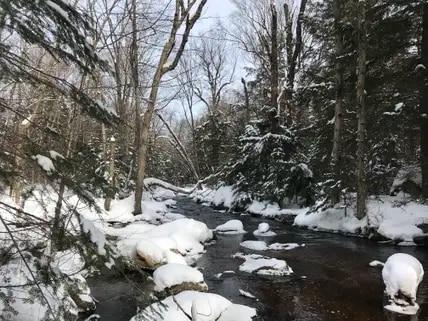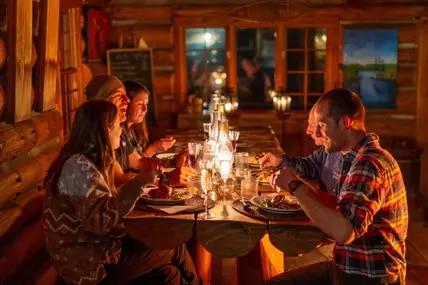Experience the serene silence of a winter journey through the snowy forests of Ontario. As we embark on our adventure with our knowledgeable guide, Baris Hekimgil, we are captivated by the rhythmic sound of the snow crunching beneath our feet. With each step, we navigate through the undulating terrain, aided by the stability of our snowshoes. This is the epitome of the Canadian wilderness we had always imagined, a picturesque winter straight out of a fairytale.
Our expedition takes an intriguing turn as Hekimgil halts and directs our attention to an indelible imprint in the snow. "A wolf track," he announces, his eyes brimming with excitement. Curious, we ponder on the number of creatures that may have tread this path. We assume it to be a solitary wolf, however, Hekimgil reveals a fascinating fact - the trail could easily be that of up to eight wolves. To navigate the snowy landscape efficiently, the entire pack cleverly follows the lead wolf's path, conserving precious energy along the way.
Climate change can also be felt here
It used to snow more here. "This winter, probably 50 centimetres less snow has fallen," estimates Hekimgil. Nevertheless, the amount of snow seems large to many tourists. They don't notice the changes caused by climate change. They don't have a comparison. "It's sad," says the guide. The ecosystem is disrupted when it snows less: wolves kill fewer deer because they can escape more easily. Hares find less food because they can no longer reach the higher branches of the trees.
Here you will find external content from Qualtrics Ireland Limited that complements this article. You can view it with one click.
I agree to external content being displayed to me. This may result in personal data being transmitted to third-party platforms. Find out more in our privacy policy.
A visit to the serene winter landscape of Algonquin Park is a must for nature enthusiasts seeking tranquility.
Nestled north of Toronto, Algonquin Park offers a remote retreat amidst its breathtaking wintry scenery.
Immerse yourself in the seclusion and beauty of the park by staying at a cozy log cabin situated on the western edge of Algonquin Park, approximately 300 kilometers away from the bustling city. With its location on the picturesque Kawawaymog Lake, this retreat ensures tranquility and a break from the distractions of urban life.
During your stay, you'll have the pleasure of experiencing the culinary delights of Sage Strength, a member of the First Nation. Recognizing the park as an escape from the stresses of everyday life, Sage Strength offers a unique indigenous ritual called smudging to cleanse negative energies. Using a feather to guide the smoke from burning sage, guests can direct the cleansing aura towards areas they feel need it most, whether it's their heart or their feet.
Embark on this winter journey to Algonquin Park and immerse yourself in the enchanting wilderness, leaving behind the noise and connectivity of the modern world.
After a day in the snow, dinner together in the log cabin is another highlight.
Ice fishing provides relaxation
We try out many of the things Canadians do in winter: Cross-country skiing, for example. And ice fishing. Mauricio Luci has drilled the necessary hole. The drill is impressively large. But fishing is a minor matter. The moon is rising. We stand together on the frozen lake, drink warming punch and connect with the vast, white solitude around us.
Luci identifies himself as a wanderer, stating that his true home lies within his trusty backpack. With a diverse background, having been born in Chile and raised in England, Luci's previous career as an architect felt confining, yearning for liberation. He holds a deep belief in the interconnectedness of humankind and nature, striving to enlighten visitors, regardless of age or profession, about this profound relationship. In his view, he hopes that a stay in the humble shelter could potentially inspire politicians to exhibit greater dedication to environmental causes.
Amidst the tranquil night, Luci surprises the group with an invitation to engage in the sport of broomball, prompting a curious reaction from his companions. Broomball, an unusual term with a hint of mystery. Eagerly following Luci and Hekimgil, they embark on a nocturnal journey towards the lake, where the illuminated pitch unfolds before their eyes, torches serving as makeshift corner flags.
Discovering the winter wonders of Ontario is truly an adventure filled with tranquility and endless snowscapes. As I ventured onto the frozen lake, I was introduced to the captivating sport of broomball, a unique derivative of ice hockey where players skillfully manipulate the ball towards the goal using branch-like sticks, reminiscent of a whimsical Harry Potter setting. The joy of sliding and frolicking on the icy surface created a magical atmosphere that is simply enchanting.
Amidst this winter realm, I encountered Mauricio, a Chilean immigrant, who shared his experience of Canada's embrace of diversity. He remarked that Canada is a nation that wholeheartedly welcomes and values individuals from all walks of life. Embarking on this journey through Ontario's winter landscapes, I not only witnessed the serene beauty of snow-covered expanses but also discovered the warmth and inclusivity that Canada extends to its immigrant community.
Experience the charm of winter in Ontario through the eyes of Bruce Bell, a former actor turned city guide in Toronto. With his captivating storytelling, Bell takes us on a journey through the historic center, where the city's roots were established by British settlers in 1793. As we explore the St. Lawrence Market and the St. Lawrence Hall meeting room, Bell shares that Old Toronto had a certain resemblance to Paris, evoking a sense of nostalgia.
Having led a fascinating life, Bell effortlessly captivates his audience with tales like drinking vodka with Marlene Dietrich at the tender age of 17. His vibrant personality shines through as he transforms the historic city into his very own stage. Through his guidance, we delve deeper into Ontario's rich history, discovering hidden wonders beneath the pristine layer of snow.
Canada has actively promoted immigration since gaining independence. Historically, the country had been discriminatory, with limited opportunities for non-white and non-British individuals, including Catholic Irish. However, the situation has drastically changed over the years.
Toronto, in particular, is recognized for its anti-discrimination policies and aims to be the most tolerant city worldwide. Canada's commitment to diversity sets it apart from its neighbor, the United States. While the US is often referred to as a melting pot where cultures blend, Canada embraces and celebrates the diversity of cultures, encouraging individuals to preserve and share their ethnic heritage while still being considered Canadian.
In contrast to its past, Canada's goal is to create a welcoming environment for immigrants, recognizing the value they bring to the country's social fabric and economy.
Immigrating to Canada provides individuals with the opportunity to engage in a society that appreciates various cultural backgrounds. Whether it's the stunning winter landscapes of Ontario or the lively multicultural cities, there are endless experiences waiting for those who choose to embark on a journey to Canada.
Experience the silence and enchantment of snow-laden landscapes during winter in Ontario, Canada. The province offers various outdoor activities, such as skiing, snowboarding, and ice skating, making it a paradise for winter enthusiasts. As the second-largest province in Canada, Ontario boasts diverse attractions, including iconic landmarks like Niagara Falls and the scenic Thousand Islands.
Everyone is welcome in Toronto - as this house façade in the Kensington Market neighbourhood shows.
Kensington Market in particular epitomises the tolerant Toronto. The immigrant neighbourhood with its many restaurants, galleries and family-owned shops is a frequently photographed attraction in the city and is considered authentic despite the many tourists. We sample some of the city's flavours on a culinary tour with food guide Jessica Halliday. We taste the diversity, so to speak. There are bagels from Krakow in Poland, enchiladas from Chile, butter tea from Tibet, gingerbread from Sweden and poutine from Canada - chips with gravy and cheese. So this is what Canada tastes like.
Manuela Imre, a journalist based in Toronto, brings a wealth of experience to her work as a correspondent for German media. Having spent twelve years in New York, she appreciates the unique qualities that both cities offer. Over breakfast, she highlights the advantages of living in Toronto, such as a comparable cost of living but with a higher quality of life. She emphasizes the city's cosmopolitan atmosphere, vibrant creative scene, and an overall sense of ease.
Contrasting her experience in New York, Manuela observes that while the Big Apple seems to have an air of transience, Toronto residents are content to call the city home. With a flourishing arts community and diverse population, Toronto's appeal lies in its ability to attract individuals from all walks of life. Appreciating the benefits offered by Toronto, Manuela enjoys her professional and personal life in the city.
From the CN Tower, once the tallest television tower in the world, visitors can see beyond the borders of Toronto.
If you visit the city on Lake Ontario in winter, the best place to warm up is on the CN Tower, once the world's tallest television tower, or in the Art Gallery of Ontario. One room of the art museum is dedicated to the landscape painters of the Group of Seven. Lawren S. Harris (1885-1970) was a frequent visitor to Algonquin Park in the 1920s. He called his paintings "Winter Woods" or "Snow, Algonquin Park". That's exactly what it looks like in the wilderness. We have experienced the snow and this wondrous silence for ourselves.
Tips for your trip to Ontario
Current situation: The Federal Foreign Office is currently warning against non-essential tourist travel to Canada. The country is considered a risk area. However, due to the coronavirus, tourist entry is currently not possible anyway.
Entry: Germans must apply for an Electronic Travel Authorisation (eTA) in advance (fee: 7 Canadian dollars). This travel authorisation is valid for five years. A visa is not required.
Best time to visit: The Canadian province of Ontario offers hot summers and cold, snowy winters. Travelling to Algonquin Park with its more than 2400 lakes is recommended all year round. However, parts of the nature park are closed from October to April and only reopen after the snow has melted. In winter, cross-country skiing, ice fishing and dog sledding are the order of the day.
Accommodation: Algonquin Park: Three days (two nights) in the Algonquin Log Cabin from tour operator Voyageur Quest cost 580 Canadian dollars, or around 380 euros, per person. The cabin directly on the lake can accommodate twelve people. There is a sauna. The solar power is switched off at night. The price includes accommodation, meals and guided ski and snowshoe tours.
If you're seeking a slightly more affordable option, think about using one of the numerous Ontario hostels. Providing a cost-effective alternative, while still offering comfort and convenience, take a look at Ontario hostels on www.ontariocahotel.com .
Those who prefer a more dignified stay can stay at The Rosseau Muskoka Resort & Spa. The luxurious Marriott hotel is located between Algonquin Park and Lake Huron.
Toronto: The Westin Harbour Castle hotel is located on Lake Ontario. The city center and the CN Tower are nearby.
If you're struggling to decide where to stay, it could be worth browsing through various hotel options on tophotels.com. The site provides comprehensive information to help you find the perfect place to rest during your stay in Toronto, including descriptions, reviews, and star ratings.



